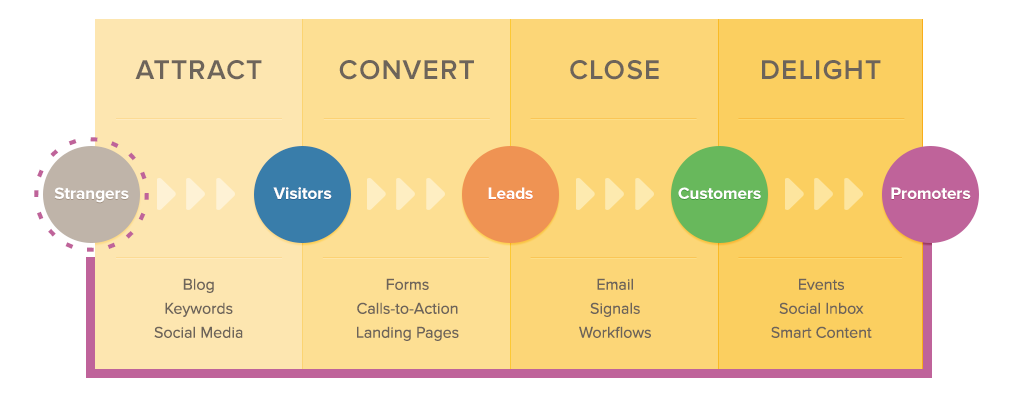
If you've not considered inbound marketing for your business, why not? Or, is it perhaps that you don't fully understand what it means and how it can benefit your business?
A Brief Overview of Inbound Marketing
After all, the term 'inbound marketing' has only been around for about ten years; it's been really gaining steam though in the past two to three years.
>> See Highlights From the State of Inbound Marketing 2013 and The State of Inbound Marketing 2014: Banish Delusion-Driven Marketing!
And although it isn't specifically mentioned at events such as #BRITEconf, inbound marketing - or truly focusing your (online) marketing on what matters to your prospects so you attract them to your site and have a chance of converting them into customers - seems to permeate every example and case study highlighted. Why? Because innovative marketing recognizes that the old ways of interrupting and disrespecting customers and consumers are tired. It acknowledges that prospects start the purchase process online, finding meaning through search and exploratory research. They no longer are willing to depend entirely on brand marketing messages.
>> See 21 Inbound Marketing Definitions vs. Outbound
>> See 15 Reasons To Embrace Inbound Marketing For Your Business
Inbound accepts that customers are in charge and that marketers and businesses must earn their trust rather than continue to bombard them with interruptive and irrelevant messages. Furthermore, attracting the right people to your site with remarkable and relevant content is a lot more fun; it makes for a stronger base for developing relationships, too.
>> See How To Create Email Marketing Customers Welcome? Show Respect!
Why Inbound Marketing For Your Business? 9 Reasons
Do you see the potential inbound has for your business? Let's go deeper. Let's specifically highlight why you need to go inboundy with your marketing.
1. The Inbound Methodology Has You Thinking About Your Customer's Journey
Going inbound makes you think about the entire journey your customer takes when doing business with you. When you consider the steps prospects take to become customers, you become aware of their questions and concerns and how to anticipate them with your content. That's how to delight customers for life!
The inbound methodology - visually represented in the graphic below - highlights the life stages of customers as they begin their buying journey, become visitors to your website, leads for your business, customers and then promoters who help you start the process over.

2. Business Can No Longer Ignore Digital Marketing!
Think of all of the things you do on your desktop, laptop, tablet and smart phone... Could you survive without those tools and the access they offer you to information? Same goes for your customers. They use they tools, when it's convenient to them - whether in the middle of the night, from a different time zone or in your town. Your website is the digital equivalent of your office, store or showroom. It's available 24/7 and needs to be fully in sync with your business to support you and educate prospects as they begin their due diligence.
In 2011, Google introduced ZMOT - or the Zero Moment of Truth - after extensive research documenting how the Internet has changed every aspect of the purchase process whether B2B or B2B: we start online and easily complete 75% of our fact finding and decision making before even reaching out to speak or interact with a business representative. Your customers do the same and if they don't come across you online - or can't even find you - you don't exist.
>> See Inbound Marketing and ZMOT: Perfect Together?
>> See Why ZMOT is Relevant for B2B Marketing: 4 Data-Based Reasons
>> See Data on Why 'Get Found Online' Matters in Marketing: ZMOT, Pew, GE Capital
3. The Days of Shouting to Get Customers' Attention Are Gone!
Have you been impressed with all the digital noise happening lately. My email inbox is inundated with Facebook, LinkedIn, Twitter, Quora and more reminders to go check out all of the notifications I'm missing out on. However, I welcome the updates and messages that I've opted into, that I've given permission to with the expectation of being respected and valued. Same goes for your customers.
>> See How Not To Get More Business: 7 eMail Retail Experience Horrors!
>> See 3 Customer Experience Tips So You Don't Abuse Your Customers
Make sure that all of your online content expresses your respect for your customer personas and your desire to help them address the issues they face. They are looking for solutions. Your website content, blog content, social content and offers all help to communicate that on behalf of your business.
Stop shouting, listen instead and you'll avoid The Breakup.
4. Start Building Trust Online!
Trust starts with listening and being respectful.
When you first meet someone in person, you exchange greetings and then begin to ask questions about the other. You listen intensely and develop conversation based on what you've learned and heard. The same needs to happen online and on your website; it comes from applying the IRL (in real life) listening to the digital environment, providing answers, anticipating an ideal path of discovery through your site, and developing thoughtful nurturing sequences for those visitors comfortable enough with you to leave an email address.
To build trust online, you'll walk in your customers' shoes to anticipate their user experience; you'll consider the tone of your content; you add images of real people in your organization and identify main points of contact. Be transparent in what to expect from working with you and the kinds of hurdles to anticipate.
Get into the habit of inviting happy customers to leave Google+ Local reviews? (BTW your Google+ Local reviews will appear in search results.) Develop guidelines for your organization so you quickly and genuinely respond when someone asks a question or expresses a concern on your Facebook page or on Twitter. Use social networks to share the human side of your business. Be consistent across platforms and profiles.
Make use of digital tools to demonstrate your credibility. It will matter to the 75% who begin their search online and come across your business.
>> See Why Building Trust With Customers Matters: 3 Expert Perspectives (be sure to check out the video!)
>> See Zappos' Online Retail Experience: Powered By Customers
>> See Managing Your Social Reputation: Highlights
5. Getting Found Online? Stay Focused. Work Hard & Smart.
It's really easy to get distracted with all of the shiny digital tools available. Embracing inbound means that you stay focused on your business goals. The inbound methodology provides you with a framework for harnessing digital tools for your business so you can evaluate and test how they deliver on your SMART goals. So, even if you go down a rabbit hole chasing pretty pictures on Facebook or Pinterest, you'll find yourself stepping back and asking yourself how you can apply what you've observed to your own social content or how to improve it.
Getting found online is not a quick fix. It's an ongoing process, a marathon of sorts. It involves frequent and consistent content, keyword research, content optimization and analysis. The more you stay focused, work hard and stay smart, the more you'll enjoy the journey. So will your customers.
>> See SMART Marketing Goals And Why You Need Them
6. Never, Ever Forget About Your Customers!
Ultimately, inbound marketing is about creating marketing that customers love. To such an extent that they can't live without you. The only way that can happen is if you focus intensely on your customers - what makes them unique, why they buy from you, how your solutions can help them, what their buyer journey is, what words they use to describe their issues, what their questions and concerns are. Be your customers' champion. Ensure everyone in your organization understands your core customer personas and how you provide them with value. Without customers, your business has no reason for being.
>> See Website Content and Your Buyer's Purchase Process
>> See The Case for Personas in Business: Connecting With Customers and Developing Personas for Content Marketing
7. Always Be Asking "And Then What?"
With an inbound methodology as framework, it becomes so much easier to think in terms of connected activities and campaigns. Too often I've seen businesses express delight in the perfect ad or promotion; all the work has gone into bringing to life that one standalone activity and none into asking "and then what?".
An interesting thing happens when you ask that question. You discover that perhaps that ad does nothing to deliver on SMART goals; that it isn't relevant to your customer personas; that is distracts from what really matters; that it's more of a boondoggle than an investment in attracting visitors and prospects, nurturing them into leads and qualifying them as potential customers. Think about next steps and how to nurture and eventually hand off qualified leads to your sales organization.
>> See Planning a Campaign? Try an Inbound Marketing Campaign!
8. Collaborate For the Benefit of Your Customers and the Business
So if you acknowledge that customers are important and you've focused everyone in your organization on delighting customers, chances are very high that you've extended inbound beyond your marketing department. The magic of inbound is that it encourages collaboration and creative thinking across departments, starting with sales and marketing. It makes you think holistically about your entire business - what's done digitally and offline - to meet the needs of customers.
Imagine unleashing that commitment and focus to help you spread the word on LinkedIn and Facebook, Instagram, Twitter and beyond. Everyone in your organization becomes your brand ambassador and a customer champion. Wow!
9. Always Be Analyzing & Learning
The days of creating something - a brochure, a website - and walking away for five years are gone. Change is more than afoot; it is a constant. What's exciting about that is that, instead of having to be perfect, you get to be constantly improving and testing and learning from your tests.
When you think inbound, you immediately think about analyzing and learning with an eye on how to improve so you do less of what doesn't work.
>> See How Website Analytics Can Inspire Your Inbound Marketing
What are you reactions?
Are you ready for inbound marketing? Do these nine reasons convince you that it's time to embrace inbound?
Why or why not? Let me know.








